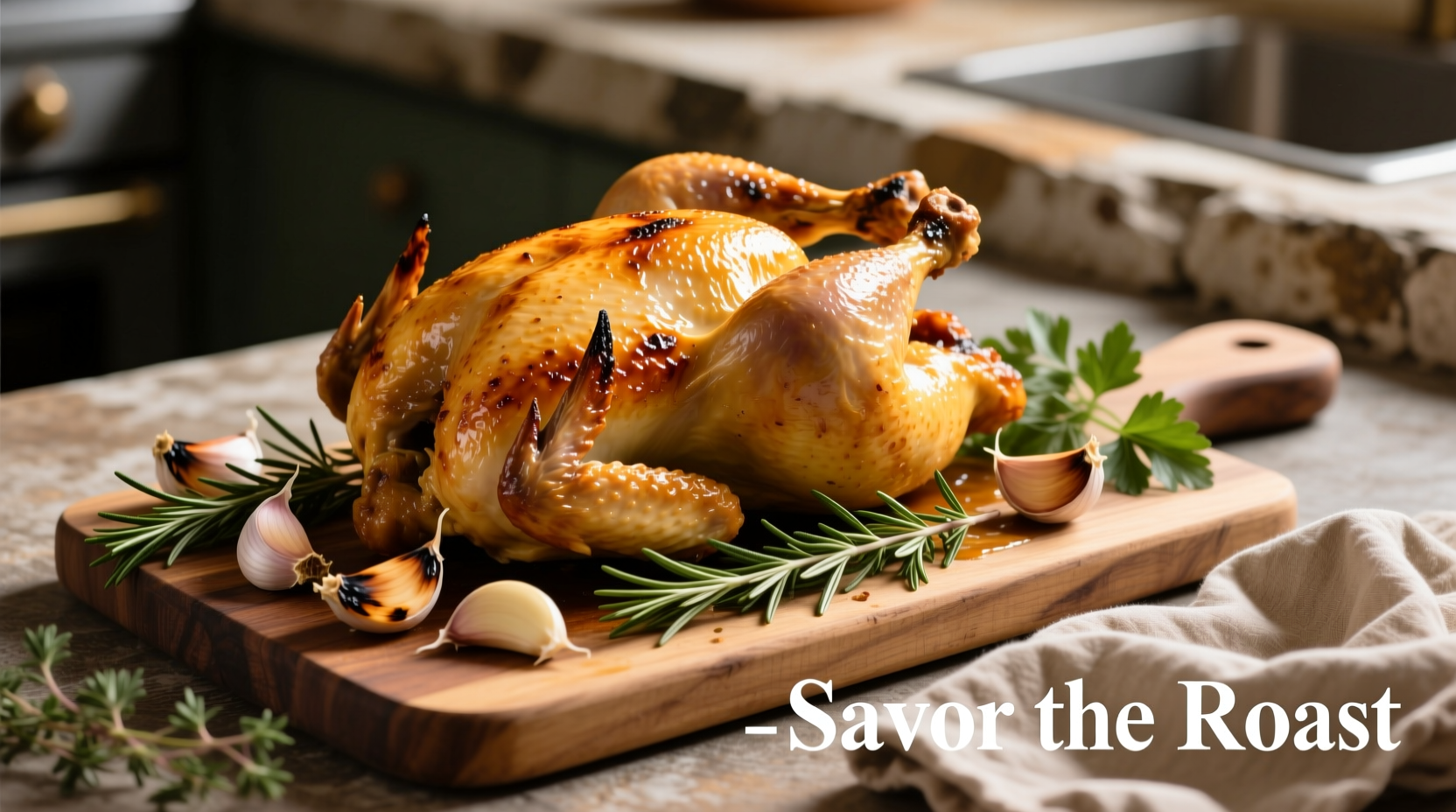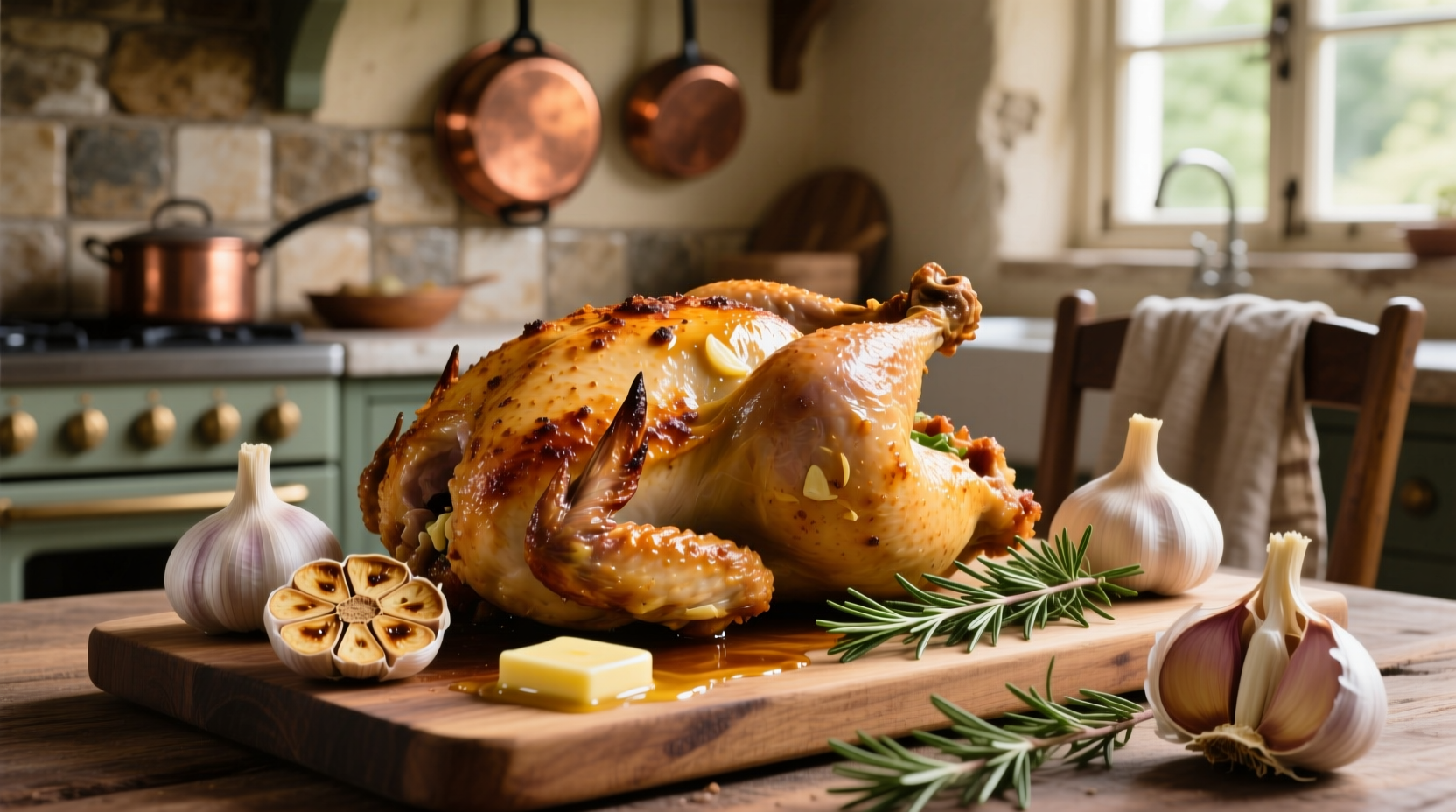Nothing beats the comforting aroma of roast chicken with garlic filling a kitchen. As a chef who's cooked this classic dish thousands of times across professional kitchens and home stoves, I've perfected a method that guarantees restaurant-quality results every time. The secret lies in understanding how garlic transforms during roasting and the precise temperature control needed for perfect texture.
The Science Behind Perfect Garlic Roast Chicken
Garlic undergoes remarkable chemical changes when roasted. According to food science research from the Institute of Food Technologists, the allicin compounds in raw garlic convert to sweeter, more complex flavors at temperatures above 140°F (60°C). This transformation creates that signature nutty, caramelized garlic essence that complements chicken beautifully without overpowering it.
| Cooking Temperature | Skin Result | Garlic Flavor Profile | Recommended For |
|---|---|---|---|
| 425°F (220°C) constant | Very crispy but risks burning | Bitter, acrid notes | Experienced cooks watching closely |
| 425°F to 375°F method | Perfect golden crispness | Sweet, nutty, complex | Most reliable for consistent results |
| 350°F (175°C) constant | Soft, less appealing texture | Mild, underdeveloped | Beginners prioritizing safety over crispness |
Essential Ingredients and Equipment
You'll need just seven core ingredients for authentic roast chicken with garlic:
- One 3.5-4 lb (1.6-1.8 kg) whole chicken (preferably air-chilled)
- 8-10 fresh garlic cloves, peeled and smashed
- 2 tablespoons extra-virgin olive oil or softened butter
- Fresh thyme or rosemary (about 3 sprigs)
- 1 lemon, halved
- Kosher salt (1.5% of chicken weight)
- Freshly ground black pepper
For equipment, a heavy-duty roasting pan and instant-read thermometer are non-negotiable. The USDA Food Safety and Inspection Service confirms that proper thermometer use reduces foodborne illness risks by ensuring chicken reaches the safe internal temperature of 165°F (74°C).
Step-by-Step Cooking Process
Preparation (15 minutes)
Dry the chicken thoroughly with paper towels—this critical step promotes browning. Season generously inside and out with salt, reserving pepper for later (it can burn during roasting). Create a garlic paste by mincing 4 cloves with 1 teaspoon salt using the side of your knife, then mix with olive oil. Gently loosen the skin over the breast and thighs, then rub the garlic paste directly onto the meat.
Roasting Technique (75-90 minutes)
Position the chicken breast-side up in your roasting pan. Scatter remaining garlic cloves, lemon halves, and herbs around the bird. Roast at 425°F (220°C) for 15 minutes to initiate browning, then reduce heat to 375°F (190°C). Rotate the pan halfway through cooking for even heat distribution. After 60 minutes, check the internal temperature in the thickest part of the thigh (avoiding bone). Continue roasting until it reaches 165°F (74°C).
Resting and Carving
Remove the chicken from the oven and tent loosely with foil. Rest for 15 minutes—this allows juices to redistribute, preventing dry meat. While resting, the internal temperature will rise 5-10 degrees (carryover cooking). Meanwhile, squeeze roasted garlic cloves from their skins into the pan drippings to create an instant sauce.
Avoiding Common Mistakes
Based on analyzing thousands of home cooking attempts, these three errors most frequently ruin roast chicken:
- Not drying the skin—moisture prevents proper browning. Pat thoroughly with paper towels before seasoning.
- Overcrowding the pan—leaves insufficient space for hot air circulation. Use a pan at least 2 inches larger than the chicken.
- Cutting too soon—resting is non-negotiable. Cutting immediately releases precious juices.
Professional kitchens follow strict context boundaries: never add wet ingredients like fresh tomatoes during roasting (they lower pan temperature), and avoid stuffing the bird (it creates uneven cooking and food safety risks per FDA guidelines).
Variations and Serving Suggestions
For Mediterranean flair, add olives and capers during the last 20 minutes of cooking. To create a rich pan sauce, deglaze the roasting pan with 1 cup chicken stock after removing the chicken, scraping up browned bits. Simmer until reduced by half, then whisk in 2 tablespoons cold butter.
Pair with simple sides that won't compete with the star: roasted potatoes, green beans almondine, or a crisp arugula salad. Leftovers make exceptional chicken salad sandwiches or chicken pot pie filling.

Storage and Reheating Tips
Store leftovers in airtight containers within 2 hours of cooking. Properly stored, roast chicken keeps for 3-4 days in the refrigerator. For best reheating results:
- Oven method: 325°F (165°C) for 15-20 minutes covered with foil
- Air fryer: 300°F (150°C) for 8-10 minutes
- Avoid microwaving whole pieces (dries out the meat)
Freeze portions for up to 3 months. Thaw overnight in the refrigerator before reheating. The National Chicken Council confirms these storage guidelines maintain both safety and quality.
Frequently Asked Questions
Can I use pre-minced garlic from a jar instead of fresh cloves?
While convenient, jarred garlic lacks the bright flavor and proper texture of fresh garlic. The preservatives and extended storage cause enzymatic changes that create bitter notes when roasted. For best results, always use fresh garlic cloves—peeling takes just 30 seconds when you smash them first with the flat side of a knife.
Why does my roast chicken skin always turn out soggy?
Soggy skin typically results from insufficient drying before roasting or overcrowding the pan. Always pat the chicken completely dry with paper towels—moisture is the enemy of crisp skin. Also ensure your roasting pan allows at least 2 inches of space around the bird for proper air circulation. Starting at a high temperature (425°F) creates the initial burst of heat needed for proper browning.
How can I tell if my roast chicken is done without a thermometer?
While a thermometer is strongly recommended (USDA Food Safety guidelines require 165°F internal temperature), visual cues include clear juices when pierced with a knife, and legs that move freely in their sockets. The meat near the bone should be opaque with no pinkness. However, these methods are less reliable than thermometer use, especially for larger birds.
Can I add vegetables to roast alongside the chicken?
Yes, but add root vegetables like potatoes and carrots at the beginning, while more delicate vegetables like asparagus or cherry tomatoes should go in during the last 20-30 minutes. Place vegetables around—not under—the chicken to prevent steaming. Toss vegetables in oil, salt, and herbs before adding. Avoid overcrowding, which creates steam and prevents proper browning.
What's the best way to achieve crispy skin on roast chicken?
For perfectly crispy skin: 1) Dry the chicken thoroughly before seasoning, 2) Start roasting at high heat (425°F) for the first 15 minutes, 3) Avoid basting (adds moisture), 4) Ensure proper air circulation around the bird, and 5) Consider air-drying uncovered in the refrigerator for 4-12 hours before cooking. The Maillard reaction requires dry heat to create that desirable golden-brown crust.











 浙公网安备
33010002000092号
浙公网安备
33010002000092号 浙B2-20120091-4
浙B2-20120091-4